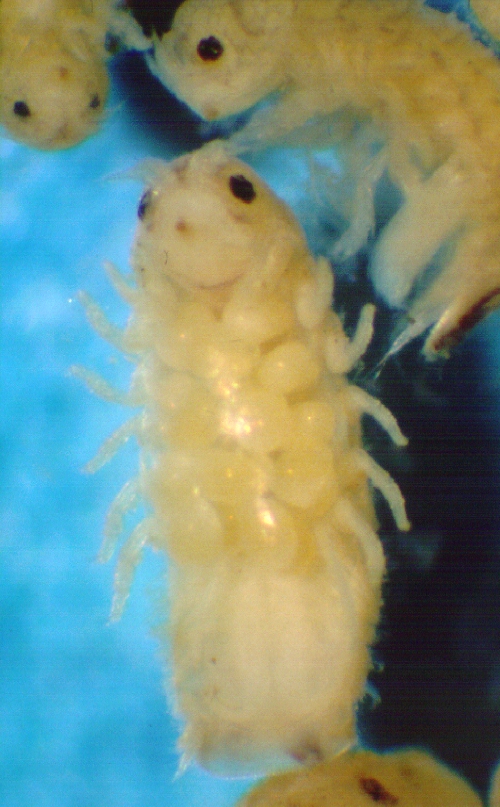- Gribble
Taxobox
name = Gribble

image_width = 250px
image_caption = "Limnoria" with eggs
regnum =Animal ia
phylum =Arthropod a
subphylum =Crustacea
classis =Malacostraca
ordo =Isopoda
familia = Limnoriidae
familia_authority = White, 1850
subdivision_ranks = Genera
subdivision = "Limnoria " "Lynseia " "Paralimnoria "A gribble is any of about 56 species of marine isopod from the family Limnoriidae. They are mostly pale white and small (1-4 mm long)
crustacean s, although "Limnoria stephenseni" fromsubantarctic waters can reach 10 mm. The term gribble was originally assigned to the wood-boring species, especially the first species described from Norway by Rathke in 1799, "Limnoria lignorum". The Limnoriidae are now known to includeseaweed andseagrass borers, as well as wood borers. There are three genera, "Paralimnoria" (two species wood boring), "Limnoria " (about 28 species wood boring, 20 species algal boring, and 3 species seagrass boring) and "Lynseia " (3 species seagrass boring). "Paralimnoria " occurs in the tropics, and has the mostplesiomorphic characters. "Lynseia" are so far known only fromAustralia , while "Limnoria" has species in most seas. Those gribbles able to bore into living marine plants are thought to have evolved from a wood (dead plant) boring species.Gribbles bore into wood and plant material for ingestion as food. The
cellulose of wood is digested, most likely with the aid ofcellulase s produced by the gribbles themselves. The most destructive species are "Limnoria lignorum", "L. tripunctata" and "L. quadripunctata". Due to dispersal while inhabiting wooden ships, it is uncertain where these three mentioned species originated. Limnoriidae are second only to theTeredinidae in the amount of destruction caused to marine timber structures such as jetties and piers. "L. tripunctata" is unusually tolerant ofcreosote , a preservative often used to protect timber piles, due to symbiosis with creosote-degrading bacteria. Gribbles bore the surface layers of wood, unlike the Teredinidae which attack more deeply. Their burrows are 1-2 mm diameter, may be several centimetres long, and have the burrow’s roof punctured with a series of smaller ventilation holes. Attacked wood can become spongy and friable.Gribbles play an ecologically important role, by helping to degrade and recycle driftwood. Most seaweed boring gribbles attack
holdfasts , and their activities can cause the seaweed to come adrift especially during storms.For defence, gribbles can jam themselves within their burrows using their
uropod s, and block the tunnel with their rear disc-shaped segment, the pleotelson.A number of crustaceans have evolved as
commensal s with Limnoriidae. "Chelura " are amphipods that inhabit the more severely attacked regions of gribble-attacked wood. "Donsiella " are tinycopepod s that inhabit the brood pouch and body of Limnoriidae.Key to genera
"See dichotomous key for instructions on using a key."
1: Body more than 6 times as long as wide. Pereopods (legs) 6 and 7 much longer than pereopod 5. Mandibular palp of at most 1 minute article. Maxillipedal palp of 1 or 3 articles. — "Lynseia"
1a: Body less than 5 times as long as wide. Pereopods 6 and 7 not much longer than pereopod 5. Mandibular palp of 0–3 articles; maxillipedal palp of 5 articles. — 2
2: Uropodal rami elongate, both with corneous apex. Antenna 1 flagellum of 5 articles. Pereopod 1 secondary unguis trifid. — "Paralimnoria"
2a: Uropodal exopod much shorter than endopod; only exopod with corneous apex. Antenna 1 flagellum with 4 or fewer articles. Pereopod 1 secondary unguis bifid, simple or sometimes with spinules. — "Limnoria"
References
* R.J. Menzies. "The marine borer family Limnoriidae (Crustacea, Isopoda). Bulletin of Marine Science of the Gulf and Caribbean.
1957 7: 101-200.
* L.J. Cookson. "Australasian species of the Limnoriidae (Crustacea: Isopoda). Memoirs of the Museum of Victoria1991 52: 137-262.
* L.J. Cookson and G.C.B. Poore. "New species of Lynseia and transfer of the genus to Limnoriidae (Crustacea: Isopoda). Memoirs of the Museum of Victoria1994 54: 179-189.
Wikimedia Foundation. 2010.
